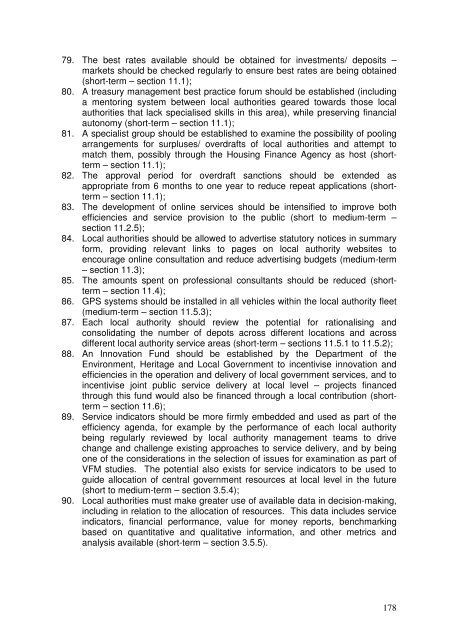Report of the Local Government Efficiency Review Group
Report of the Local Government Efficiency Review Group
Report of the Local Government Efficiency Review Group
Create successful ePaper yourself
Turn your PDF publications into a flip-book with our unique Google optimized e-Paper software.
79. The best rates available should be obtained for investments/ deposits –<br />
markets should be checked regularly to ensure best rates are being obtained<br />
(short-term – section 11.1);<br />
80. A treasury management best practice forum should be established (including<br />
a mentoring system between local authorities geared towards those local<br />
authorities that lack specialised skills in this area), while preserving financial<br />
autonomy (short-term – section 11.1);<br />
81. A specialist group should be established to examine <strong>the</strong> possibility <strong>of</strong> pooling<br />
arrangements for surpluses/ overdrafts <strong>of</strong> local authorities and attempt to<br />
match <strong>the</strong>m, possibly through <strong>the</strong> Housing Finance Agency as host (shortterm<br />
– section 11.1);<br />
82. The approval period for overdraft sanctions should be extended as<br />
appropriate from 6 months to one year to reduce repeat applications (shortterm<br />
– section 11.1);<br />
83. The development <strong>of</strong> online services should be intensified to improve both<br />
efficiencies and service provision to <strong>the</strong> public (short to medium-term –<br />
section 11.2.5);<br />
84. <strong>Local</strong> authorities should be allowed to advertise statutory notices in summary<br />
form, providing relevant links to pages on local authority websites to<br />
encourage online consultation and reduce advertising budgets (medium-term<br />
– section 11.3);<br />
85. The amounts spent on pr<strong>of</strong>essional consultants should be reduced (shortterm<br />
– section 11.4);<br />
86. GPS systems should be installed in all vehicles within <strong>the</strong> local authority fleet<br />
(medium-term – section 11.5.3);<br />
87. Each local authority should review <strong>the</strong> potential for rationalising and<br />
consolidating <strong>the</strong> number <strong>of</strong> depots across different locations and across<br />
different local authority service areas (short-term – sections 11.5.1 to 11.5.2);<br />
88. An Innovation Fund should be established by <strong>the</strong> Department <strong>of</strong> <strong>the</strong><br />
Environment, Heritage and <strong>Local</strong> <strong>Government</strong> to incentivise innovation and<br />
efficiencies in <strong>the</strong> operation and delivery <strong>of</strong> local government services, and to<br />
incentivise joint public service delivery at local level – projects financed<br />
through this fund would also be financed through a local contribution (shortterm<br />
– section 11.6);<br />
89. Service indicators should be more firmly embedded and used as part <strong>of</strong> <strong>the</strong><br />
efficiency agenda, for example by <strong>the</strong> performance <strong>of</strong> each local authority<br />
being regularly reviewed by local authority management teams to drive<br />
change and challenge existing approaches to service delivery, and by being<br />
one <strong>of</strong> <strong>the</strong> considerations in <strong>the</strong> selection <strong>of</strong> issues for examination as part <strong>of</strong><br />
VFM studies. The potential also exists for service indicators to be used to<br />
guide allocation <strong>of</strong> central government resources at local level in <strong>the</strong> future<br />
(short to medium-term – section 3.5.4);<br />
90. <strong>Local</strong> authorities must make greater use <strong>of</strong> available data in decision-making,<br />
including in relation to <strong>the</strong> allocation <strong>of</strong> resources. This data includes service<br />
indicators, financial performance, value for money reports, benchmarking<br />
based on quantitative and qualitative information, and o<strong>the</strong>r metrics and<br />
analysis available (short-term – section 3.5.5).<br />
178
















